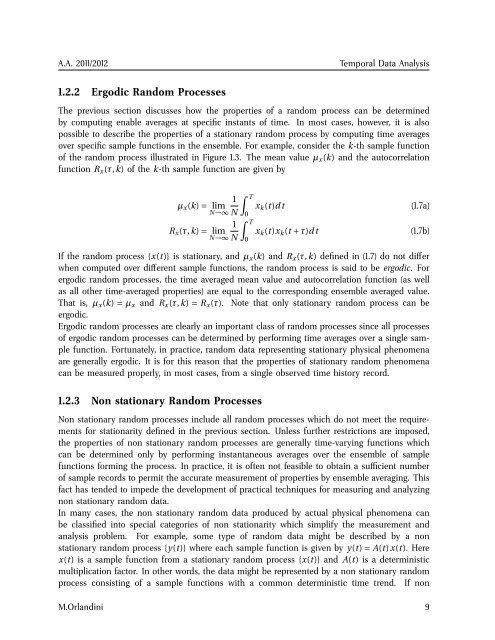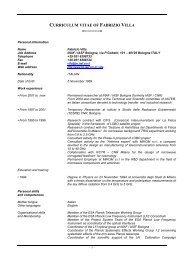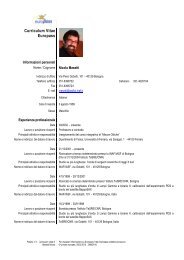booklet format - inaf iasf bologna
booklet format - inaf iasf bologna
booklet format - inaf iasf bologna
Create successful ePaper yourself
Turn your PDF publications into a flip-book with our unique Google optimized e-Paper software.
A.A. 2011/2012<br />
Temporal Data Analysis<br />
1.2.2 Ergodic Random Processes<br />
The previous section discusses how the properties of a random process can be determined<br />
by computing enable averages at specific instants of time. In most cases, however, it is also<br />
possible to describe the properties of a stationary random process by computing time averages<br />
over specific sample functions in the ensemble. For example, consider the k-th sample function<br />
of the random process illustrated in Figure 1.3. The mean value µ x (k) and the autocorrelation<br />
function R x (τ,k) of the k-th sample function are given by<br />
∫<br />
1 T<br />
µ x (k) = lim x k (t)dt<br />
N→∞ N 0<br />
∫<br />
1 T<br />
R x (τ,k) = lim x k (t)x k (t + τ)dt<br />
N→∞ N<br />
0<br />
(1.7a)<br />
(1.7b)<br />
If the random process {x(t)} is stationary, and µ x (k) and R x (τ,k) defined in (1.7) do not differ<br />
when computed over different sample functions, the random process is said to be ergodic. For<br />
ergodic random processes, the time averaged mean value and autocorrelation function (as well<br />
as all other time-averaged properties) are equal to the corresponding ensemble averaged value.<br />
That is, µ x (k) = µ x and R x (τ,k) = R x (τ). Note that only stationary random process can be<br />
ergodic.<br />
Ergodic random processes are clearly an important class of random processes since all processes<br />
of ergodic random processes can be determined by performing time averages over a single sample<br />
function. Fortunately, in practice, random data representing stationary physical phenomena<br />
are generally ergodic. It is for this reason that the properties of stationary random phenomena<br />
can be measured properly, in most cases, from a single observed time history record.<br />
1.2.3 Non stationary Random Processes<br />
Non stationary random processes include all random processes which do not meet the requirements<br />
for stationarity defined in the previous section. Unless further restrictions are imposed,<br />
the properties of non stationary random processes are generally time-varying functions which<br />
can be determined only by performing instantaneous averages over the ensemble of sample<br />
functions forming the process. In practice, it is often not feasible to obtain a sufficient number<br />
of sample records to permit the accurate measurement of properties by ensemble averaging. This<br />
fact has tended to impede the development of practical techniques for measuring and analyzing<br />
non stationary random data.<br />
In many cases, the non stationary random data produced by actual physical phenomena can<br />
be classified into special categories of non stationarity which simplify the measurement and<br />
analysis problem. For example, some type of random data might be described by a non<br />
stationary random process {y(t)} where each sample function is given by y(t) = A(t) x(t). Here<br />
x(t) is a sample function from a stationary random process {x(t)} and A(t) is a deterministic<br />
multiplication factor. In other words, the data might be represented by a non stationary random<br />
process consisting of a sample functions with a common deterministic time trend. If non<br />
M.Orlandini 9

















